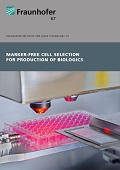For the OptisCell process, the three partners have devised a combined system concept that enables them to analyze and transfer cells. The system provides UV and MIR beam sources for the LIFT process and features a three-objective and five-axis system for flexible handling. Thus, transfer and receiver carriers can be moved independently in the x and y directions with a repeat accuracy down to 100 nm and at speeds of up to 3 m/s relative to each other. The lenses are accessible via a third axis (z-axis). OptisCell will make it possible to transfer cells more quickly and without contact.
In several studies, CHO cells were used for Raman analysis and transfer. With both UV and MIR laser radiation, the LIFT process was successful here in up to 85 percent of the transfers. Transferred CHO cells survive and proliferate for up to seven days. The survival rate of the transferred cells is about 60 percent after the seven days. The plant has been designed to operate on a workbench, allowing treatment of the cells in a sterile and air-conditioned environment. This significantly increases the survival rate of the cells and thus the efficiency of the process.

 Fraunhofer Institute for Laser Technology ILT
Fraunhofer Institute for Laser Technology ILT